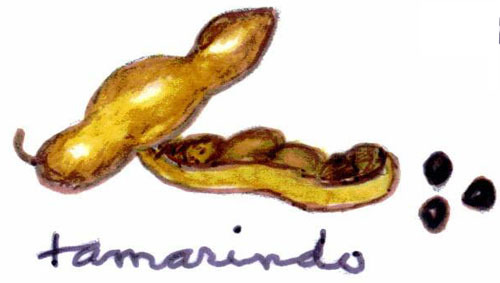Mexican Kitchen

With the hugely burgeoning interest in international cooking, tamarinds have found a place in U.S. markets. An ingredient in Thai and Indian recipes, they are used in Mexico to make aguas and dulces de tamarindo: tamarind drinks and candies. The pods of the tamarind tree, which was brought to Mexico from India, contain large seeds surrounded by a sticky brown pulp, which is sold as tamarind paste for use in Asian cooking. Tamarind pods are sold in bulk in large markets and in smaller ones catering to Thai, Indian and/or Latino communities.
Ingredients:
- 10 tamarind pods
- 1 quart water
- 3/4 cups sugar, or to taste
Preparation:
Peel the tamarind pods, removing the veins that run along the sides. Don’t worry if bits of the pod adhere to the pulp; they will come off easily after cooking. Do not attempt to remove the seeds at this point.
Bring half the water to a boil and add the peeled tamarind pods. Boil until the pulp is soft, about 15 minutes.
Let the tamarind water sit until the pulp is cool enough to handle.
Using your hands, remove the seeds from the pulp; they will slide out easily. Discard the seeds and any bits of outside peel that may have stuck before cooking.
Put the pulp, cooking water and sugar in the blender and liquify.
Strain this mixture into a pitcher and add the remaining water.
Mix well and chill before serving.
Note: If you have kids who like to fingerpaint, use play dough, or enjoy any other gooey activities, let them help cleaning the tamarinds. My daughter and her friends particularly liked squeezing the shiny black seeds out of the pulp after cooking. They also developed a taste for snacking on the tamarinds while doing so (not a bad habit, since tamarinds are loaded with vitamin C.) Just make sure their hands are clean.


